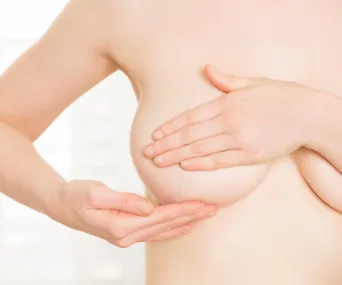Going for a mammogram is hardly a fun thing to do, but preventative screening tests are the best way to detect diseases early.
The Royal Australian College of General Practitioners (RACGP) and BreastScreen Australia recommend that low risk women aged 50-74 who aren’t showing any symptoms have routine screening mammograms every two years.
But recent research has found that a whopping 64 per cent of women have never had a preventative screening test for breast cancer.
Unlike the majority of Aussie women, 55 year-old Paola Incerti has been going for regular breast screenings since the age of 21.
“I had been quite routinely screened,” Paola tells Now To Love. “I have very dense breasts which means whenever you do your own regular breast screening it feels like everything is a lump so from a very early age I’ve been having breast screenings.”
With no family history of breast cancer, Paola always assumed she’d be fine.
But in August 2017 at the age of 53, when she visited Sydney’s Royal Prince Alfred Hospital’s breast screening clinic that’s free for anyone over 50, she was called back for a second mammogram and ultrasound a week later.
Doctors then told her that they’d found two lumps.

Despite not having a family history of breast cancer, 55 year-old Paola has been going for regular breast screenings since the age of 21.
(Image: Supplied)Paola admits that she didn’t suspect anything was wrong.
“There are lots of lumps and I’ve had cysts that were biopsied. I always thought things were cysts,” she explains.
“You can do something for so long and you just assume that nothing’s ever going to change and it did so it’s a very good lesson in not being complacent I guess.”
Despite the unpleasant surprise, Paola never felt panicked and the doctors working with her made sure to stay cool, calm and collected.

“There are lots of lumps and I’ve had cysts that were biopsied.”
(Image: Getty Images)“They never panic you, I was called back for a re-check the next week and at that one I met the surgeon who said ‘Look, we’ve seen this, this is why we’re calling you back and if I’m concerned with the second imaging then we’ll do a biopsy if you’re comfortable with that in the week and then we’ll take those results.'”
“It was bitesize so that I could manage and it wasn’t this real shock. They did it quite well at RPA in a manner that was like ‘Okay I’ll wait for next week,’ so I was almost prepared for the next thing that was going to happen the week after. They led me through it without surprises in a sense.”
WATCH: Five breast cancer symptoms that don’t come in the form of a lump. Post continues after video…
Despite the pragmatism from the doctors, telling her loved ones was particularly tough.
“It’s quite a devastating thing, I think it’s one of the worst things you have to do in your life telling your children and husband. That’s probably one of the hardest things I’ve ever done in my life,” Paola confesses.
“Ringing people and going ‘Hi how are you? I’ve got some news,’ it’s the same thing if you’ve ever had to tell people someone’s died. It’s one of those things you just don’t want to do and everyone reacts differently and processes it differently. My daughter didn’t process it straight away but it came out in other ways. That was one of the worst things for me.”

“It’s one of those things you just don’t want to do and everyone reacts differently and processes it differently.”
(Image: Getty Images)Paoloa’s biopsy and CT scan was just a week after her second mammogram and ultrasound and she was soon taken in for surgery.
“It was really well done and I was in surgery within a month so it was incredibly efficient. You just think ‘Thank god they moved so quickly,’ and in my case that was important because there were two lumps and it was also in two lymph nodes so it was quite critical they moved and they did so I was quite fortunate.”
After her surgery, Paola then underwent three months of chemotherapy and three months of radiotherapy, but says that the medical advances these days are pretty phenomenal.
“We’re at the forefront of treatment in Australia and they spell out all the potentials. Before the surgery, the surgeons said that if they did find it in the lymph nodes, they will remove those lymph nodes and they also said that if the lumps are also in an area where they cannot remove just the breast tissue, they will have to do a mastectomy so they spell out all the potentials. They said ‘We could remove just the lump, potentially we could also have to do a mastectomy,’ so you’re given all the scenarios and in my case I was really fortunate.”
WATCH: Nanna knits “knockers” for women who’ve had mastectomies. Post continues after video…
In the end, Paola underwent a skin preserving mastectomy, which means the nipple and skin of the breast is left intact but the breast tissue is removed.
Instead, an expander is put in to replace the breast tissue during chemotherapy and radiotherapy and at the end of that, a breast implant is inserted.
“It’s so much less invasive than in previous times. Because they preserve the skin and nipple, you’re not having to reconstruct. With anything where they have to reconstruct the whole tissue and skin and nipple, they have to remove skin from either your leg or stomach and so then it’s a big reconstructive job and Australia has some of the worst reconstruction rates in breast cancer so it was amazing. So within two years I now have a breast implant and feeling fantastic.”

Two years on and Paola is feeling fantastic.
(Image: Supplied)Paola was in New York with her daughter when she received the text that said she was in good health. Two years on from her diagnosis, she only has to meet with her surgeon, oncologist or radio oncologist every three months. And she credits her screenings for why she’s still here today.
“One in eight women will have breast cancer so if I took lotto out on those chances, I’d have really great chance of getting it. Once we reach 50 the risk just shoots up so the fact that we can get these free screenings after 50, we’re just really fortunate and I’m very fortunate.”
And while she admits the process of going for a mammogram can be daunting, it’s worth the discomfort.
“It’s super intimidating going and thinking ‘Oh my god what if I found a lump,’ but I don’t view it that way. I see it as ‘Oh my god I’m so lucky they found it,’ I really have a different perspective on it. It’s intimidating and scary, you have to face that concept of your mortality but honestly much better facing that early.”

Paola was in New York when she received the news that she was in good health.
(Image: Supplied)Dr Sally Phillips, TAL General Manager, Health Services says that women need to take a proactive approach to their health and wellbeing so that health conditions, like breast cancer, can be caught early.
“Having a screening mammogram is quick and easy – it only takes around 20 minutes and could save your life,” she explains.
“Screening is dependent on any individual woman’s risk and your GP is best to advise when you should start having regular screening and how frequently.”
Free screening mammograms are offered every two years to all Australian women aged 40 and over, but women under the age of 50 won’t be sent a free screening invitation letter.
“Women who have been referred for a screening mammogram by their doctor may have to pay a fee. While there is a Medicare rebate for screening mammograms, many private imaging clinics charge more than the Medicare Schedule Fee. This means that women who use these services must pay the balance,” Dr Phillips adds.
“Some private health insurers may pay a benefit for screening mammography, so best to check with your health fund as to whether these mammograms are covered and up to what amount.”

The Cancer Council of Australia provides free screening mammograms every two years to all Australian women aged 40 and over.
(Image: Getty Images)Paola’s experience has also encouraged her friends and family to get checked.
Speaking about her daughter, Paola says, “In a way she’s had a blessing because she’s been forewarned and she can change her lifestyle and be proactive with screening so for her that’s a good thing.”
“There were girls in the hospital, one was 23 and that was just heartbreaking so she typically wouldn’t have followed that course of screening. If it was in your family, whether that’s bowel or breast cancer, absolutely go before 50. Early is always better in the health world. Let’s face it you can always deal with that issue when it’s an earlier case.”
“It can be random or lifestyle and the funny thing is when I told my friends they said ‘I’ve been putting it off, I’ll go do it now.’ I hadn’t even told them to do it and they went so it did encourage a lot of friends of my age to not put it off. People are so busy but I’m so glad they found the time.”
For more information on mammograms, visit the Cancer Council website here. or the BreastScreen Australia website here.



